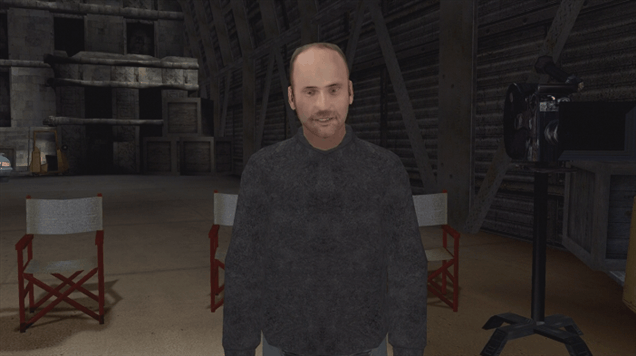Few outside of a rather tightly-knit following of gamers know the intensity that brewed deep within the studio called Quantic Dream. As a fan of the titles, I thought we could delve deeper into the fascinating yet humble beginning of this studio. We’ve all got to start somewhere, right?
I make no bones about the fact I’m a pretty sharply attuned fan of Quantic Dream. While you may see some sonorous love in pockets of this piece, it’s more about discussing the studio, its charismatic (and sometimes maligned) head game director and studio co-owner and the games they release. Quantic Dream has been in the gaming sphere since 1999 (the studio opened in 1997) but in its twenty years as a studio, it has only released four titles with the fifth to come late this May. Before I get too ahead of myself, let’s start from the beginning.
David Cage, Gaming Music Producer turned Creative Director:
David De Gruttola isn’t a name most would recognize despite the fact De Gruttola took on the last name Cage in 1997 when founding Quantic Dream. Cage had, alias aside, been working on a handful of smaller games as a music director. None of these were too terribly well-known, mind you. Seemingly working on contact with Warner Brothers and Universal Pictures separate gaming divisions, he developed music for a Speedy Gonzales game as well as the video game adaptation of TimeCop. Yes. TimeCop. Hey, at least all he had to take credit for was the music.
Omikron: The Nomad Soul aka Cage Dares to Dream:
Cage went on in 1997 to create Quantic Dream whose first title out of the gate was a David Bowie infused title called Omikron: The Nomad Soul. With the help of David Bowie and composer Reeves Gabrels to compose and perform eight songs for the game, Cage hoped it would be a solid start for the newly born gaming studio. The game had promise also, but as seems to be a complaint that fans of David Cage’s fever dreams will give you, they’re always so far ahead of their time. Omikron was seemingly lost on the late nineties wave of game reviewers who felt the concepts were too piled upon one another. The game offered you different visual perspectives, rich audio and a soundtrack to die for, but the story seemed almost too intense to gamers who were having a hard time figuring out this new style of game. Fans of this cult classic, however, would tell you that it was simply ambitious and possibly too much so for what was being offered at the time. In a land of candy-coated platformers, foreign roleplaying game ports and a brand new love for survival horror games, Omikron simply faded before the eyes of typical gaming fans. It wasn’t being touted by a typical publisher and so with only Eidos Interactive to tell their story, Omikron stayed in the hands of the few that were lucky enough to understand it.
Fahrenheit aka: Indigo Prophecy
Music has always had a heavy hand in David Cage’s games because, as he has stated before, music builds on your own personal soundtrack daily so it made sense to infuse it into his own intimate way of storytelling. Finding the band Theory of a Deadman to fill the audience with a sense of what kind of music its protagonist would lean into, Cage found his place in holding cinematic court. Now with the help of Guillaume de Fondaumière coming into Quantic Dream as Chief Operating Officer, Cage had more time to craft his games in a direction he felt comfortable with. Indigo Prophecy was new for its time, and much like Omikron, was possibly even ahead of the, no-pun-intended, game. Angelo Badalamenti and Normand Corbeil composed the game with such an intense precision that you were left with the music after the game ended. When Lucas, Indigo Prophecy’s main character, finds his final fight – it’s Badalamenti, Corbeil and Theory of a Deadman that linger. Cage’s attention to detail with music coupled with an interactive movie style of gaming were spoken about almost non-stop. The game was rife with quick-time events, a gaming component where the action is not done through anything but button-presses that are timed within a specific scene. While most games relied on this only for inconsequential actions and nothing of importance save for Kratos knocking a wall down ala God of War, Cage used this component to give the player a sense of accomplishment while still telling the story. These were either timed in order to further your progress or they were moral choices you made in order to lead to a specific ending. Gamers at the time weren’t sure what to make of it and you had a very divisive audience because of it.
Players who understood and appreciated this new style of gaming defended it almost non-stop. In 2005, when Indigo Prophecy released in that fall, it was shipped after behemoths from larger studios were already planted and rooting. Resident Evil 4, Capcom’s re-introduction to their brooding horror series and Sony’s God of War had already been released and were reviewer darlings by the time Indigo Prophecy released in September. Two months later, Guitar Hero revolutionized rhythm games and that was how quickly Cage’s game went from an indie blip on the radar to buried beneath the giants. Granted, far more people talked about this bright up-and-coming studio with a lot of promise than when Omikron came out — but Cage realized he still had work to do. As reviewers and journalists touted him as more of a movie director than a game designer, he knew he would have to push the envelope even further.
The Casting Tech Demo aka: The Tease Before the Rain
Not even a full year after Indigo Prophecy, Quantic Dream released a ‘tech demo‘ for an untitled game. This was to show their further work on motion capture, something the studio was well known for, and further advances into emotional gameplay rather than what was currently the popular offerings. The tech demo hinted at something new they were working on and fans of Indigo Prophecy, coming off the high of completing its story and consistent replays, were ready for whatever Cage’s crew could offer next. The tech demo was brooding, featuring a woman auditioning for a part with Cage speaking off-camera. The scene grows intense and sets a tone for what would become Quantic Dreams’ break-away hit Heavy Rain.



